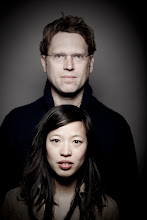08.20.2009 Japanese vending machine product of the day: Sake!

Timing is everything here in Kyoto. We are finding that one cannot do too much here, nor too quickly. Living in New York City, we've been so accustomed to being able to live a 24 hour day, eating whenever and wherever. Mornings are best reserved for temples and shrines. Shops operate between 10 or 11 am until 5 or 6 pm. Museums keep much of the same hours, but some close as early as 4:30 pm. Restaurants open around 10 or 11am, and usually stop serving lunch at latest 2pm, opening back up for dinner at 5 pm, then closing anywhere between 6 pm through 9 pm. Not big on breakfasts here. If you need to eat before 10 am, best to have a meal plan where you're staying or go to a convenience store, like Lawsons, where you can pick up a yogurt or Japanese rice balls with seaweed and other packaged meals. The best way to plan your day is to be loose about it and limit yourself to one main zone of Kyoto each day. Today we focused on Shugakuin and Ichijoji areas of northeastern Kyoto along the foothills of Higashiyama. We based this itinerary from Exploring Kyoto: On Foot in the Ancient Capital by Judith Clancy. It's a great guide to help you find hidden spots not located on most tourists maps, however, the maps are simplistic and not to scale. It was a little exasperating, as we couldn't find Saginomori Shrine, despite what seemed like clear written directions. We even stopped and asked a land surveyor, who flipped the map several times trying to figure the orientation and with a confused looked, pointed us roughly in the direction we were to head. We weren't able to hit all the landmarks on the walk, but here were just a few:
Shugakuin Imperial Villa This villa was commissioned by the retired Emperor Gomizuno. He abdicated his throne at the age of 33, when the shoguns were taking hold of the country, leaving his 5 year old daughter to the throne. From 1655 - 1659, he occupied himself with the construction of this villa of about 133 acres.
Entrance fee: Free, but shown by appointment only through the Imperial Household Agency.
The tours are in Japanese, with scant English brochures. A Guide to the Gardens of Kyoto by Marc Treib and Ron Herman offers a more in-depth information and a great comprehensive guide to this villa.

Entrance approach to the Lower Villa

Jugetsukan - resting place for Emperor before going up to the Upper Villa


Pine lined path to Middle Villa

Kyakuden - Middle Villa

Rinuntei - Upper Villa



Kyusuitei- the highest point of the islet in the middle of the pond, where the Emperor would sit and look out at the garden.


Outside of the Sugakuin Imperial Villa
Nestled in the grounds of a small shrine near Manshuin is Benten-chaya, a noodle shop, serving up chilled zaru soba noodles in dashi sauce and mountains of matcha flavored shaved iced. Perfect way to cool off from the heat and humidity.



Manshuin This temple was founded in the 8th century on Mt. Hiei, but moved here in 1656. It's known for its shoin-style rooms dated from the Edo period, which were writing rooms or study rooms for the abbot. The main garden is a quiet space of raked gravel and multiple layers of trees, where we rested.
Entrance fee: 500 JPY. Open 9-4:30





A view of rice patties along our hike to visit temples

Enkoji, once a former nunnery, 1667. The temple was built to promote scholarship in Japan. It also claims to have the oldest landscaped pond. We weren't allowed to take photos here, but here's a picture of a gekko that Johnny rescued from being entangled in a large spider web.
Entrance fee: 400 JPY. Open 9-4:30

Shinsendo Villa of samurai, Ishikawa Jozan. It's known for kare sansui - dry landscaped garden.
Entrance fee: 500 JPY. Open 9-5.




 Images from our walk back to Ichijoji Station:
Images from our walk back to Ichijoji Station:

This is Tanuki. From Japanese folklore, it's a raccoon dog with a barrel belly and large kintama or golden balls (testicles). He is reputed to be mischievous. Can be a wily shapeshifter that can seduce unwary strangers. Watch out! He is everywhere in Kyoto, on front yards, doorsteps, store fronts.


I adore this Fiat 600
Dinner at Hirano-Ya. Near our hotel, this restaurant is just inside the north gate of Maruyama Park. About 100 years hold, it serves traditional Kyoto cuisine. Hours 10:30 am-8 pm.



Dozens of small dining rooms along a stone walkway


Imobo -small potatoes with dried cod, clear broth with yuba - soy milk skin with eggs and fish and the ever famous Kyoto pickles

No comments:
Post a Comment